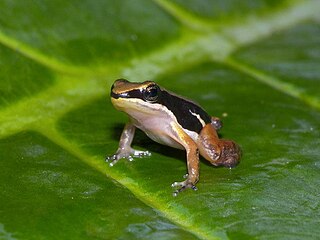
Colostethus is a genus of poison dart frogs native to Central and South America, from Panama south to Colombia, Ecuador, and northern Peru. Their common name is rocket frogs, but this name may refer to frogs in other genera and families, following the taxonomic revision of the genus in 2006.

Silverstoneia flotator, the rainforest rocket frog, is a terrestrial, diurnal frog found in humid lowlands of Costa Rica and Panama. It is considered to be of least concern by the IUCN. The taxonomy is in need of a review, as it may consist of a complex of several species.
Leucostethus alacris or the Finca Primavera rocket frog is a species of frog in the family Dendrobatidae. It is endemic to Colombia.
Hyloxalus breviquartus is a species of frog in the family Dendrobatidae. It is found in the northern part of Cordillera Occidental in Antioquia, Colombia, and in Carchi Province in northwestern Ecuador. Colombian distribution may be wider. Its natural habitats are montane forests next to streams and very humid premontane forests. It is threatened by habitat loss, although it occurs in the Las Orquídeas National Natural Park, its type locality.
Hyloxalus edwardsi is a species of frogs in the family Dendrobatidae. It is endemic to the Cordillera Oriental in the Cundinamarca Department, Colombia.

Leucostethus fraterdanieli is a species of frog in the family Dendrobatidae. It is endemic to the Andes in Colombia. Colostethus yaguara might be its junior synonym.
Leucostethus fugax, also known as Pastaza rocket frog, is a species of frog in the family Dendrobatidae. It is endemic to the eastern slopes of the Cordillera Oriental, southern Ecuador. Although originally only known from the valley of Pastaza River, it is now known to be more widespread. Its known range extends close to the Peruvian border and its true range may include Peru.
Hyloxalus fuliginosus or the Quijos rocket frog is a species of frog in the family Dendrobatidae. It is endemic to Ecuador where it is known from the Amazonian slopes of the Andes in the northern Ecuador, with some sources reporting it from Colombia and Venezuela.
Colostethus imbricolus is a species of frog in the family Dendrobatidae. It is endemic to Colombia.
Colostethus latinasus is a species of frog in the family Dendrobatidae. It is known from Cerro Pirre in Darién Province, Panama, from Chocó Department in adjacent Colombia, and from Tierralta, Córdoba Department, Colombia.

Colostethus panamansis, also known as the Panama rocket frog or (ambiguously) common rocket frog, is a species of poison dart frog. It is found in northwestern Colombia and Panama. It is one of the best studied poison dart frogs; however, until 2004 Colostethus panamansis was considered a synonym of Colostethus inguinalis, and consequently the older literature uses that name.

Colostethus pratti is a species of frog in the family Dendrobatidae. It is found in the northwestern Colombia and Panama, possibly also in southeastern Costa Rica. It is sometimes known as the Pratt's rocket frog. Colostethus pratti is named after Antwerp Edgar Pratt, an explorer who collected the type series.
Leucostethus ramirezi is a species of frog in the family Dendrobatidae that is endemic to Colombia. It is only known from the region of its type locality, Urrao in the Antioquia Department.
Hyloxalus ruizi is a species of frogs in the family Dendrobatidae. It is endemic to Colombia and only known from the Eastern Ranges of the Colombian Andes, in the Cundinamarca Department.

"Colostethus" ruthveni is a species of frog in the family Dendrobatidae. It is endemic to the Magdalena Department in northern Colombia. The specific name ruthveni honors Alexander Grant Ruthven, an American herpetologist. It is known from the lower slopes of the north-western portion of the Sierra Nevada de Santa Marta. Its natural habitats are tropical dry forests and cloud forests where it occurs near streams, and is threatened by habitat loss. Males of this species on average have a snout-vent length of 18.9–20.1 millimetres (0.74–0.79 in) whereas females average about 19.8–24.1 millimetres (0.78–0.95 in).
Leucostethus yaguara is a species of frog in the family Dendrobatidae. It is endemic to Colombia where it is only known from its type locality, Ituango, on the Cordillera Occidental in the northern Antioquia Department. It might be conspecific with Colostethus fraterdanieli. Scientists observed the frog in the leaf litter near streams in cloud forest habitat are approximately 1475 meters above sea level.
Ameerega ingeri, also known commonly as Niceforo's poison frog, Brother Niceforo's poison frog, or Inger's poison frog, is a species of frog in the family Dendrobatidae. The species is endemic to the Colombian Amazon. It is known with certainty only from its type locality in the Caquetá Department. Records from the Putumayo Department ascribed to this species likely refer to Ameerega bilinguis, although other sources continue to include Putumayo in the range of Ameerega ingeri.
Pristimantis cabrerai is a species of frog in the family Strabomantidae. It is endemic to Colombia and is known from the Cordillera Occidental in Antioquia and Caldas Departments. Although common name Valle robber frog has been suggested for it, the specimen from Valle del Cauca is no longer assigned to this species.
Strabomantis ingeri, also known commonly as Inger's robber frog, is a species of frog in the family Strabomantidae. The species is native to Colombia.
Gastrotheca bufona is a species of frog in the family Hemiphractidae. It is endemic to Colombia and known from the Cordillera Central and Cordillera Occidental in Antioquia and Caldas Departments, at elevations of 1,430–2,200 m (4,690–7,220 ft) asl. The specific name bufona is derived from Spanish bufón, meaning a jester or clown, and refers to the frog's "gaudy" appearance.






